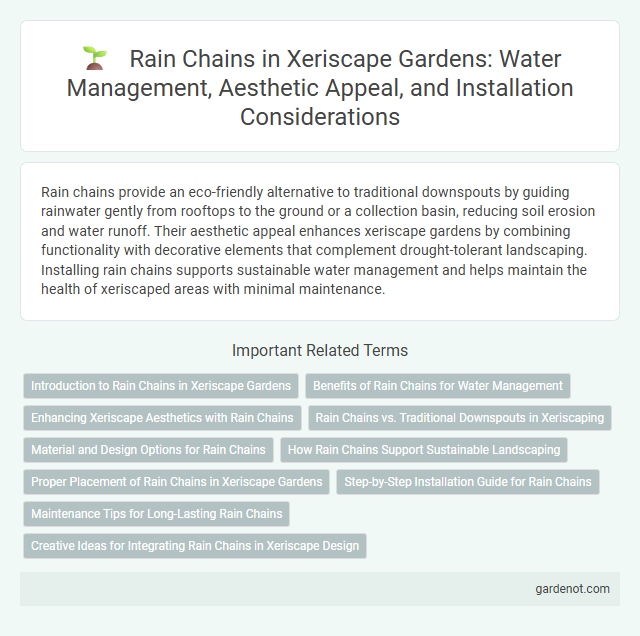Rain chains provide an eco-friendly alternative to traditional downspouts by guiding rainwater gently from rooftops to the ground or a collection basin, reducing soil erosion and water runoff. Their aesthetic appeal enhances xeriscape gardens by combining functionality with decorative elements that complement drought-tolerant landscaping. Installing rain chains supports sustainable water management and helps maintain the health of xeriscaped areas with minimal maintenance.
Introduction to Rain Chains in Xeriscape Gardens
Rain chains, a functional and aesthetic alternative to traditional downspouts, enhance water flow management in xeriscape gardens by guiding rainwater gently from rooftops to the ground or collection areas. These structures, often crafted from copper or aluminum cups or links, facilitate water conservation by directing rainfall toward plants and soil, reducing erosion and promoting groundwater recharge. Integrating rain chains in xeriscape landscapes supports sustainable water usage, complements drought-tolerant plantings, and enriches garden design with natural sound and visual appeal.
Benefits of Rain Chains for Water Management
Rain chains improve water management by directing rainwater from roofs to drainage systems or rain barrels, reducing soil erosion and water pooling. Their design allows for controlled water flow and enhances groundwater recharge by slowing runoff. Rain chains also serve as aesthetic and functional components in xeriscape landscaping, promoting efficient water use in drought-prone areas.
Enhancing Xeriscape Aesthetics with Rain Chains
Rain chains transform xeriscape gardens by directing rainwater visually and functionally, enhancing water conservation while adding elegant vertical lines. These chains, often made from copper or aluminum, create soothing water sounds that complement the natural drought-tolerant landscape. Integrating rain chains into xeriscape design boosts aesthetic appeal and showcases sustainable water management in arid environments.
Rain Chains vs. Traditional Downspouts in Xeriscaping
Rain chains in xeriscaping provide a visually appealing and functional alternative to traditional downspouts by directing rainwater gently into ground basins or rain gardens, minimizing soil erosion and promoting water absorption. Unlike rigid downspouts, rain chains slow the flow of water, facilitating better infiltration and reducing runoff in drought-prone landscapes. Their aesthetic design complements xeriscape principles by combining water conservation with natural, decorative elements.
Material and Design Options for Rain Chains
Rain chains are crafted from various materials such as copper, aluminum, stainless steel, and resin, each offering unique durability and aesthetic appeal suitable for xeriscape landscapes. Design options range from simple cup-shaped chains to intricate lotus or bamboo styles, enhancing water flow and visual interest while promoting efficient rainwater drainage. These diverse materials and designs optimize water conservation and complement drought-tolerant garden themes.
How Rain Chains Support Sustainable Landscaping
Rain chains enhance sustainable landscaping by directing rainwater efficiently from rooftops to the ground, reducing soil erosion and minimizing water waste. Their design promotes natural water filtration and absorption, fostering healthier plant growth without relying on complex irrigation systems. Incorporating rain chains into xeriscape gardens complements drought-tolerant plantings and conserves water resources effectively.
Proper Placement of Rain Chains in Xeriscape Gardens
Rain chains should be strategically placed to guide water from downspouts directly into rain barrels, basins, or permeable garden areas to maximize water conservation in xeriscape gardens. Positioning rain chains near drought-tolerant plants helps channel water efficiently, reducing runoff and promoting deep soil absorption. Ensuring proper placement also prevents erosion and directs runoff away from foundations, supporting sustainable landscaping practices.
Step-by-Step Installation Guide for Rain Chains
Begin by selecting a rain chain made of durable materials such as copper or stainless steel, ensuring it complements your xeriscape design while effectively channeling water. Next, remove the existing downspout, install a rain chain hook or eye bolt securely into the gutter's downspout hole, and attach the rain chain links or cups in sequence. Finally, place a decorative basin or gravel bed beneath the rain chain's outlet to collect and absorb rainwater, minimizing runoff and promoting water conservation in the xeriscape landscape.
Maintenance Tips for Long-Lasting Rain Chains
Rain chains require periodic cleaning to prevent debris buildup and ensure smooth water flow, which is essential for their longevity in xeriscape gardens. Inspect and tighten connections regularly to avoid leaks and maintain structural integrity under varying weather conditions. Applying a protective sealant can also help preserve metal rain chains from rust and wear caused by prolonged exposure to sun and rain.
Creative Ideas for Integrating Rain Chains in Xeriscape Design
Rain chains enhance xeriscape design by directing water flow visually and efficiently while minimizing soil erosion. Incorporating materials like copper or zinc not only adds a rustic aesthetic but also ensures durability under varied weather conditions. Positioning rain chains near native drought-tolerant plants creates a harmonious balance between water conservation and artistic landscape elements.
Rain chain Infographic

 gardenot.com
gardenot.com